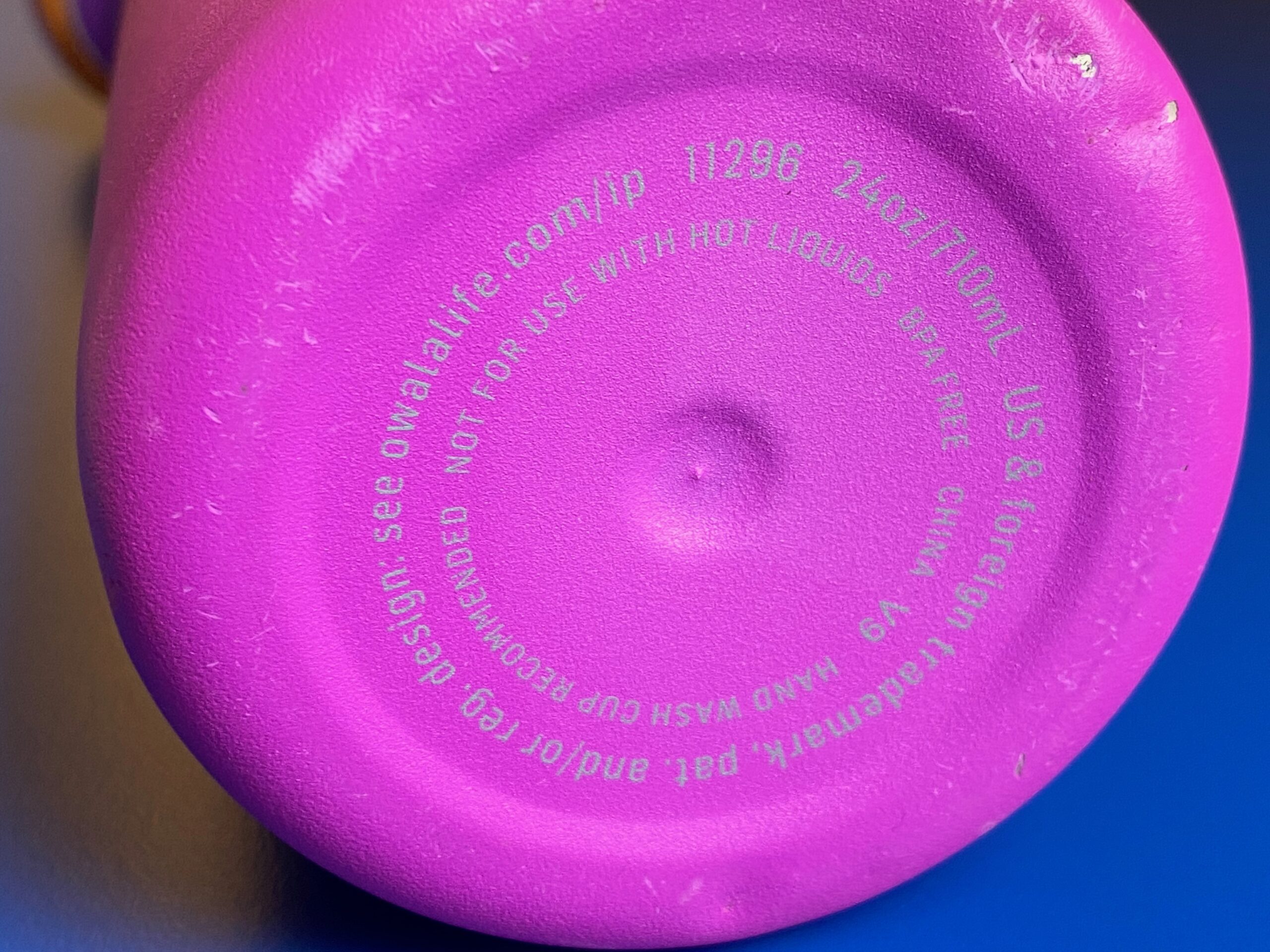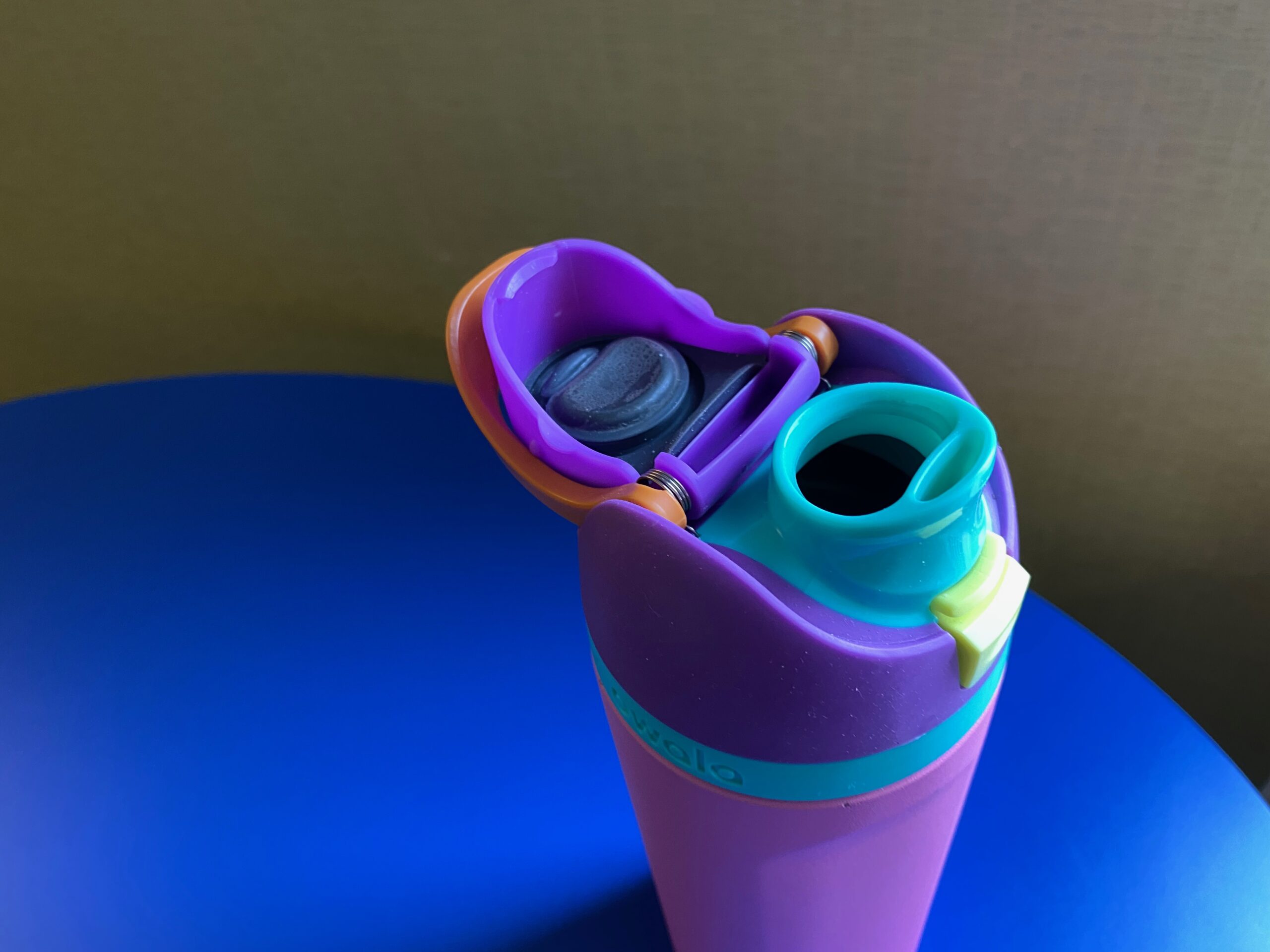Pink insulated stainless steel water bottle by Owala: Lead-free! (This is the only product I have tested from this brand)
Published: February 12, 2022
Insulated stainless steel water bottle by Owala
(owalalife.com)
I had never heard of this brand before it was sent to me by a reader. Continue reading below each of the images to see the XRF test results for the component pictured. There are 10 separate test results below for 10 separate components of this bottle.
Here’s a Lead Safe Mama Amazon affiliate link for bottles from this brand: https://amzn.to/3LwEYVK.
To see more water bottles I have tested, click here.
Reading #1) Sealing dot
30-second test
- Lead (Pb): non-detect
- Cadmium (Cd): non-detect
- Mercury (Hg): non-detect
- Bromine (Br): 39 +/- 26 ppm
- Chromium (Cr): 7,821 +/- 1,195 ppm
- Vanadium (V): 211,000 +/- 3,200 ppm
- Iron (Fe): 1,326 +/- 433 ppm
- Zinc (Zn): 15,700 +/- 300 ppm
- Titanium (Ti): 196,200 +/- 3,600 ppm
- Tin (Sn): 488,800 +/- 2,700 ppm
- Barium (Ba): 78,700 +/- 1,000 ppm
- Gold (Au): 473 +/- 132 ppm
- No other metals were detected in consumer goods mode.

Reading #2) Pink exterior on side
30-second test
- Lead (Pb): non-detect
- Cadmium (Cd): non-detect
- Mercury (Hg): non-detect
- Bromine (Br): non-detect
- Chromium (Cr): 77,000 +/- 3,500 ppm
- Vanadium (V): 97,500 +/- 2,700 ppm
- Manganese (Mn): 16,000 +/- 1,200 ppm
- Iron (Fe): 118,600 +/- 6,000 ppm
- Cobalt (Co): 8,412 +/- 678 ppm
- Nickel (Ni): 11,700 +/- 800 ppm
- Copper (Cu): 1,012 +/- 136 ppm
- Zinc (Zn): 87 +/- 43 ppm
- Titanium (Ti): 337,500 +/- 6,700 ppm
- Zirconium (Zr): 468 +/- 35 ppm
- Niobium (Ni): 393 +/- 45 ppm
- Molybdenum (Mo): 2,132 +/- 160 ppm
- Tin (Sn): 53 +/- 21 ppm
- Barium (Ba): 34,800 +/- 2,200 ppm
- No other metals were detected in consumer goods mode.
Reading #3) Green painted logo on side
30-second test
- Lead (Pb): non-detect
- Cadmium (Cd): non-detect
- Mercury (Hg): non-detect
- Bromine (Br): 45 +/- 11 ppm
- Chromium (Cr): 49,000 +/- 2,700 ppm
- Vanadium (V): 97,900 +/- 3,100 ppm
- Manganese (Mn): 14,200 +/- 1,200 ppm
- Iron (Fe): 62,300 +/- 3,400 ppm
- Cobalt (Co): 6,051 +/- 536 ppm
- Nickel (Ni): 7,006 +/- 512 ppm
- Copper (Cu): 559 +/- 112 ppm
- Titanium (Ti): 372,600 +/- 8,800 ppm
- Zirconium (Zr): 560 +/- 39 ppm
- Niobium (Ni): 614 +/- 51 ppm
- Molybdenum (Mo): 2,086 +/- 154 ppm
- Tin (Sn): 52 +/- 20 ppm
- Barium (Ba): 44,000 +/- 2,800 ppm
- No other metals were detected in consumer goods mode.
Reading #4) Teal/ light-blue plastic logo area/ inside of cap (includes spout)
30-second test
- Lead (Pb): non-detect
- Cadmium (Cd): non-detect
- Mercury (Hg): non-detect
- Bromine (Br): non-detect
- Chromium (Cr): non-detect
- Copper (Cu): 28 +/- 8 ppm
- Titanium (Ti): 2,069 +/- 175 ppm
- Barium (Ba): 158 +/- 63 ppm
- No other metals were detected in consumer goods mode.
Reading #5) Purple hard plastic cap
30-second test
- Lead (Pb): non-detect
- Cadmium (Cd): non-detect
- Mercury (Hg): non-detect
- Bromine (Br): non-detect
- Chromium (Cr): non-detect
- Barium (Ba): 281 +/- 63 ppm
- No other metals were detected in consumer goods mode.
Reading #6) Orange plastic of cap
30-second test
- Lead (Pb): non-detect
- Cadmium (Cd): non-detect
- Mercury (Hg): non-detect
- Bromine (Br): non-detect
- Chromium (Cr): non-detect
- Copper (Cu): 8 +/- 5 ppm
- Titanium (Ti): 917 +/- 120 ppm
- Barium (Ba): 140 +/- 49 ppm
- No other metals were detected in consumer goods mode.
Reading #7) Purple silicone of sides of cap
30-second test
- Lead (Pb): non-detect
- Cadmium (Cd): non-detect
- Mercury (Hg): non-detect
- Bromine (Br): non-detect
- Chromium (Cr): non-detect
- Zinc (Zn): 61 +/- 6 ppm
- Barium (Ba): 491 +/- 94 ppm
- No other metals were detected in consumer goods mode.
Reading #8) Interior stainless — ss 304
30-second test
- Lead (Pb): non-detect
- Cadmium (Cd): non-detect
- Mercury (Hg): non-detect
- Bromine (Br): 25 +/- 8 ppm
- Chromium (Cr): 184,000 +/- 700 ppm
- Vanadium (V): 1,407 +/- 171 ppm
- Manganese (Mn): 12,800 +/- 500 ppm
- Iron (Fe): 714,500 +/- 1,200 ppm
- Nickel (Ni): 81,900 +/- 800 ppm
- Copper (Cu): 3,357 +/- 184 ppm
- Zinc (Zn): 68 +/- 35 ppm
- Titanium (Ti): 275 +/- 180 ppm
- Molybdenum (Mo): 1,431 +/- 63 ppm
- Tin (Sn): 92 +/- 17 ppm
- Barium (Ba): 93 +/- 58 ppm
- No other metals were detected in consumer goods mode.
 Reading #9) Yellow hard plastic latch
Reading #9) Yellow hard plastic latch
30-second test
- Lead (Pb): non-detect
- Cadmium (Cd): non-detect
- Mercury (Hg): non-detect
- Bromine (Br): non-detect
- Chromium (Cr): 116 +/- 29 ppm
- Iron (Fe): 450 +/- 22 ppm
- Nickel (Ni): 47 +/- 7 ppm
- Copper (Cu): 14 +/- 6 ppm
- Titanium (Ti): 845 +/- 134 ppm
- Barium (Ba): 251 +/- 54 ppm
- No other metals were detected in consumer goods mode.
 Reading #10) Black silicone valve
Reading #10) Black silicone valve
30-second test
- Lead (Pb): non-detect
- Cadmium (Cd): 8 +/- 3 ppm (Safe by all standards).
- Mercury (Hg): non-detect
- Bromine (Br): non-detect
- Chromium (Cr): non-detect
- Niobium (Nb): 461 +/- 13 ppm
- No other metals were detected in consumer goods mode.
Amazon links are affiliate links. If you purchase something after clicking on one of these links, Lead Safe Mama, LLC may receive a percentage of what you spend at no extra cost to you.
Some additional reading/ links for those not yet familiar with this work:
- To learn more about the testing methodology employed for the results reported on this website, click here.
- For a quick menu to explore more categories of items we have tested and published on this website, click here.
- For a quick video tutorial showing you how to most efficiently use this website (including all the ways to find Lead-free consumer goods we have tested and reported on), click here.
- To learn more about hiring Tamara for a one-on-one home consultation or a small community event, click here.
- To find out how to send a single item in for testing, click here.
- Please follow us on Instagram, Facebook, and Twitter!
- Please subscribe to the Lead Safe Mama, LLC e-mail newsletter to be among the first to see any and all newly published test results here on the website, too!
- To check out our new(ish) site that only has Lead-free things for sale, click here!
For those new to this website:
Tamara Rubin is a multiple-Federal-award-winning independent advocate for childhood Lead poisoning prevention and consumer goods safety, and a documentary filmmaker. She is also a mother of Lead-poisoned children (two of her sons were acutely Lead-poisoned in 2005). Since 2009, Tamara has been using XRF technology (a scientific method used by the U.S. Consumer Product Safety Commission) to test consumer goods for toxicants (specifically heavy metals — including Lead, Cadmium, Mercury, Antimony, and Arsenic). All test results reported on this website are science-based, accurate, and replicable. Items are tested multiple times to confirm the test results for each component tested. Tamara’s work was featured in Consumer Reports Magazine in February of 2023 (March 2023 print edition).
Never Miss an Important Article Again!
Join our Email List




















Could there be a lead sealing dot under that paint?
Wondering the same thing as I’m staring at my own Owala bottle
Is the cadmium is this bottle considered a problem?
Hello! Would you deem these safe? Or could there be a seating dot under the paint?
Thank you!
Is the cadmium on the seal an issue?
Hi, thank you for your mission in supplying test results for all that are concerned. I do not know how to interpret the tests. Do you have a water bottle that you recommend, that is safe?
Thank you,
Gloria
This one is a good choice for water – or anything from Hydroflask.
Hi Tamara,
Do you know if TAL 24 ounce tumbler, Sip by Swell 17 ounce, and Mayim 32 ounce tumblers contain lead.
I do not believe those brands are Lead-free.
T
Does this mean that the solder dot is lead free?
Yes
So cadmium will not leach with water use?